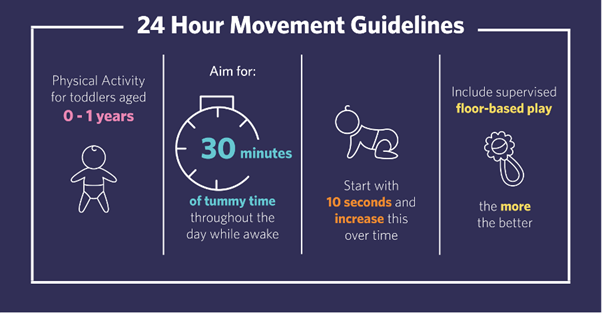
Tummy time and starting to move (0-8 months)
Giving your baby time on their tummy will help to build up strength to lift and hold they head and shoulders up. Tummy time should be started soon after birth and start with 1-2 minutes, 2-3 times a day and increase the time as your baby becomes stronger. By the age of 4 months, you should be aiming for 10-15 minutes at least 3 times a day. In the first 8 months of life, this will help them to develop skills needed to roll over, crawl and sit up.
Your baby will spend a lot of time sleeping on their back with their head in one position. Spending time on their tummy can help to prevent babies from getting a flat spot on their head.
The more practice your baby gets, the easier it will be for them to learn and remember.

Tummy time
There are a few different ways to do tummy time with your baby. Your baby may not always enjoy lying flat on their tummy or they may have colic or reflux. If this is the case, you can try any of the following positions to find something that you both enjoy:
For a newborn, lie your baby face down on your chest, lap, or arm as pictured.

For younger babies, try using a tummy time pillow or rolled-up towel.

Tips for tummy time:
-
Choose a time when your baby is awake and alert. Make sure there is time between food and tummy time to allow for the digestion of milk.
-
Stay with your baby during tummy time to ensure that they are safe
-
As your baby grows stronger you can put them on a rug on the floor to play
-
Try various locations including outside in warm weather
-
Use toys, bubbles, and mirrors to help keep tummy time interesting and fun
-
If your baby becomes sleepy put them on their back to sleep in their cot
-
When your baby has better control of their head and arms, give them a ball to play with
-
Encourage your baby by getting down on the floor and playing with them during tummy time.
Starting to move
From 3-6 months your baby will begin to move. They may start reaching for their legs and toys while on their back and reaching for toys and rolling from their tummy to their back during tummy time. To help babies learn to roll:
-
Cross one of your baby’s legs over their body, roll gently backwards and forwards. Do the same on the other side
-
Place a toy out of reach on the side they are rolling to
-
Set up a slope using a cushion and assist baby to roll down (give them practice on the left and right side)
From 6 months, your baby may begin moving in circles around the floor during tummy time and they will usually prefer tummy time rather than being on their back. They may be learning to sit with or without support, and when they are ready, they might even try crawling. To help babies learn to crawl:
-
Give them plenty of tummy time so they can develop the strength in their shoulders, arms, back and torso that helps them to crawl
-
You can sit behind your baby during tummy time and place your hands against their feet. Your baby’s legs should be a little bent so they can push on your hands to move forward
It is important to remember that every baby is different and not all babies will reach physical development milestones at the same time. This is completely normal. If you are concerned about your baby's movement, please reach out to your local GP (General Practitioners) or paediatrician for more help and information.
For more information on Tummy Time and play ideas for newborns visit Raising Children:
Movement and play ideas for newborns
Related Articles:
Baby's first steps (8-12 months)
[Raising Children Network, 2020; The Royal Children's Hospital Melbourne, 2022.]
Related Topics

Play is an important part of your baby’s development and can be used throughout your daily routine.

